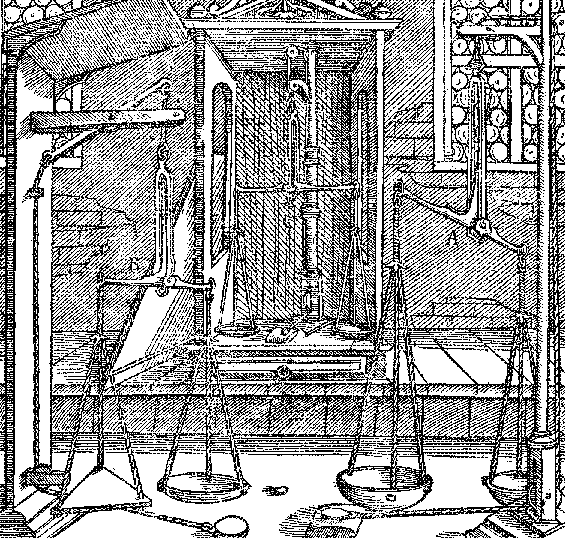
This work's copyright has lapsed, and it is now in public domain.
Thanks are due to Jimena Canales for providing the photocopy from which this
posting was made
by John Michael Williams
As was customary at that period in France, Urbain Le Verrier, Director of the Paris Observatory and Member of the Academy, presented Wolf's treatise to the Academy.
When a telescope is trained in a certain direction, the rotation of the Earth will make astronomical objects move in the field of view. Wolf defines personal equation as the constant error of observation in recording the time of coincidence of the image of a star and a vertical cross-hair in the eyepiece of a telescope. Such an observation is called a transit pass, or transit time, in astronomy. In the case of the Paris Observatory, transit times would be used to define the Earth's angle in terms of the fixed stars, and thus to define the sidereal time of day. The exact time of day would be used to calibrate a mechanical clock. Such clocks were carried on ships to compute the longitude and thus to navigate safely.
Transit times were recorded at the Paris Observatory by an 'eye-and-ear' method in those days: As the image of the star approached the cross-hair, the astronomer began counting ticks heard from a clock; after noting the transit pass, the astronomer then could look up and enter the time as estimated from the tick count.
Wolf begins by describing how to measure an astronomer's personal equation in order to correct it. He uses a mirror to project artificial star images which move at a known speed, and the astronomer presses a telegraph key when the artificial coincidence seems to occur. After a series of 40 decisions, the difference between actual time of passage and the astronomer's mean recorded time of passage is computed; this constitutes the correction peculiar to the astronomer's personal equation. Wolf claims that measurement in his apparatus, combined with an understanding of the causes of observational differences, allows transit observations to be made with an accuracy of 1/100 second.
Wolf says he uses Bradley's method of visual interpolation and recording of time by the transit observer, rather than an automatic recording (chronographic) method. He says he built his artificial star apparatus in late 1863 to study why astronomers differed in their times. He found that practice in the apparatus could reduce his own errors from about 0.30 sec to 0.11 sec. However, beyond this [constant] error, he could not improve further. Seeing this benefit, he then decided to train the Observatory's staff on such a device.
While experimenting to decide on the training, Wolf says he found he could not influence his constant error by changing the amount or angle of illumination of the cross-hairs; nor did position of the head of the observer seem to matter.
However, Wolf was able to characterize his constant error in terms of the direction of motion and speed of the artificial star, and eyepiece magnification. He speculates that perhaps an asymmetry of the retina might account for directional dependence; he notes that his error seemed minimal for a particular speed; and, finally, he finds that increased magnification seemed to reduce the constant error.
As for the cause of personal-equation constant errors, Wolf surveyed several observatories and found that constant errors differing by more than one second occurred among astronomers. He mentions that Faye had taken Bessel's position that the problem was that the eye (viewing the star) and ear (listening for the tick of the timing pendulum clock) are fundamentally disjoint senses for which simultaneity is to some extent undefined. Hence, different observers shift the eye vs ear event times differently.
However, muses Wolf, it is known that musicians in an orchestra can eliminate all such differences with training; they all play their note at the instant the baton moves. Therefore, the personal equation errors can be cancelled by training ones internal clock beat ("battement interieur") to correspond with that of the observatory pendulum standard clock. Wolf denies the Faye assertion entirely ("cette intervention des deux sens n'existe pas").
Notice here that Wolf does not seem to understand the difference between synchronizing several repetitive (periodically continued) intervals with the baton versus synchronizing an isolated transit event with one of the intervals provided by the clock.
Wolf then reports several phenomenological observations supporting his training idea: For example, he speculates that the eye has limited space-time coordination because of visual persistence of moving images, caused sometimes by eye movements. Therefore, one can learn to cancel ones personal equation error by learning where the eye will over- or under-estimate locations, and interpolating (by analogy to musicians hearing up-beats vs down-beats). The eye alone is responsible for personal equation, a claim Wolf calls a purely physiological sensory function, when contrasted with Faye's idea.
Wolf concludes (1) that errors because of personal equation are very predictable; (2) that the traditional eye-and-ear method of transit timing is superior to the chronographic method, which latter entails a certain variability because of activation of the marker by hand movement; and (3) although errors indeed initially are smaller when using the chronographic method, the education of astronomers is better served by training them to make eye-and-ear observations.
Back to Pulfrich Effect Home. University Privacy Policy
The Pulfrich Effect, SIU-C. Last updated 2001-04-17